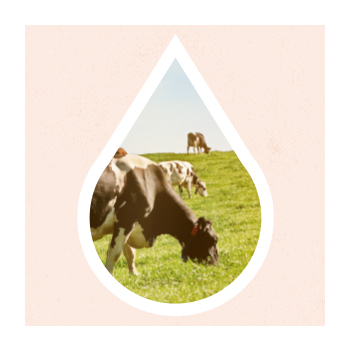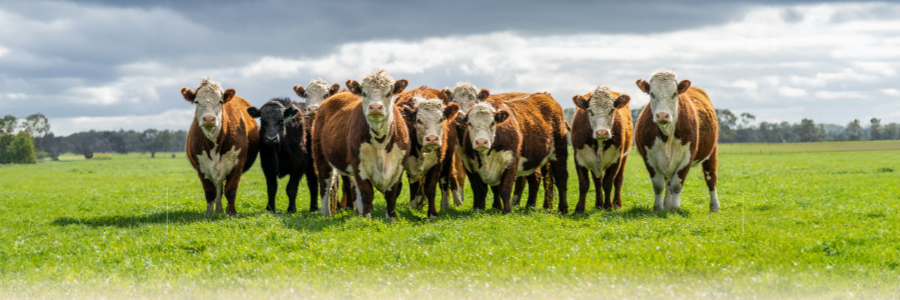 Many of the water issues we face are worsened (or even caused) by the degenerative practices of conventional agriculture. Monoculture crops, bare fields, excessive use of tillage and synthetic chemicals, and concentrated animal feeding operations rob the soil of organic matter and biodiversity—essential ingredients for healthy function, including water infiltration.2 3 4 5 Agriculture is also one of the largest contributors to nitrogen and phosphorous pollution in water, a significant factor in the widespread occurrence of toxic algae blooms.6 7 8 It’s estimated that half the nitrogen and phosphorous applied to fields as fertilizer end up in the surrounding environment.9 Yet, this isn’t a requirement of modern food production. Regenerative agriculture can restore harmony and functionality to nature’s cycles and support resilient food-producing systems in a changing climate.10 11
Many of the water issues we face are worsened (or even caused) by the degenerative practices of conventional agriculture. Monoculture crops, bare fields, excessive use of tillage and synthetic chemicals, and concentrated animal feeding operations rob the soil of organic matter and biodiversity—essential ingredients for healthy function, including water infiltration.2 3 4 5 Agriculture is also one of the largest contributors to nitrogen and phosphorous pollution in water, a significant factor in the widespread occurrence of toxic algae blooms.6 7 8 It’s estimated that half the nitrogen and phosphorous applied to fields as fertilizer end up in the surrounding environment.9 Yet, this isn’t a requirement of modern food production. Regenerative agriculture can restore harmony and functionality to nature’s cycles and support resilient food-producing systems in a changing climate.10 11
The regenerative solution
Soil is one of agriculture’s most critical resources for improving drought and flood resilience and reducing water pollution.12 13 14 15 Healthy soil can absorb and retain much of its volume in water, and it only takes a one percent increase in soil organic matter to increase its water storage potential by approximately 20,000 gallons per acre.16 17 18 Imagine the potential impact this could have on California, where approximately 80 percent of the publicly developed water supply goes to agriculture.19 20 The National Resources Defense Council estimates that if farmers adopted cover crops and other regenerative practices on half of California’s field crop acreage, they could store an additional 10.9 billion gallons of water in the soil!21

Evidence from the farm
Regenerative farmers and ranchers practice the core principles of soil health adapted to the ecological context of their operations, building soil high in organic matter with the structure to support water infiltration and retention.22 23 Consider these outcomes from the farm: In early 2023, California experienced a series of heavy rainstorms after a drought, causing disastrous flooding and crop losses for many farmers.24 A Civil Eats op-ed highlighted the resilience of several regenerative operations in the state by contrast. Singing Frogs Farm in Sonoma County started spring planting on schedule despite receiving more than 13 inches of rain in just a few weeks.25 Additionally, although their lower fields flooded 11 of the last 15 winters, the excess water was absorbed and retained in the soil rather than causing severe damage.26 Similarly, Paicines Ranch, in San Benito County, told Civil Eats that their hilltop vineyard has experienced zero runoff since they began managing it regeneratively in 2017,27 and the soil could hold ALL the water the latest series of storms had unleashed.28
On the other side of the country, the Chesapeake Bay Foundation measured the environmental outcomes of converting conventional farmland on six farms in its region to rotationally grazed pasture, and the water pollution benefits were significant—nitrogen was reduced by 63 percent, phosphorous by 67 percent, and sediment by 47 percent on average.29
It makes economic sense
Adopting agricultural conservation practices commonly used in regenerative operations, like managed grazing, reduced tillage, and cover crops, is a smart investment—the Chesapeake Bay region's Watershed Implementation Plans for pollution reduction recommends these practices. It would also boost local economies by an estimated $655 million annually if the states sharing the watershed implemented them all. And some cost far less to implement than the conventional alternative. For example, it takes a $7.62 investment in forest buffers to reduce a pound of nitrogen, but it takes $2,350 in animal waste management systems to see the same result.30
In 2022, the top 10 commodities produced by U.S. farms included cattle, dairy products, hogs, broilers (chicken), and eggs.31 Support farmers raising these foods in a manner that regenerates the land. Put hope on the menu.
References
- “Bill Mollison Quotes (Author of Permaculture).” Goodreads, Goodreads, www.goodreads.com/author/quotes/217513.Bill_Mollison. Accessed 24 Jan. 2024.
- “Chapter 5. Creating Drought-Resistant Soil.” The Importance of Soil Organic Matter, www.fao.org/3/a0100e/a0100e08.htm. Accessed 24 Jan. 2024.
- Longenecker, Sarah. “Nurturing Nature’s Filter: Soil Health and Its Influence on Water.” Rodale Institute, 25 July 2023, rodaleinstitute.org/blog/connecting-soil-health-and-water-quality/. Accessed 24 Jan. 2024.
- Team, White Oak Pastures. “The Cycles of Nature: How We Regenerate Land.” Around The Farm Blog, blog.whiteoakpastures.com/blog/the-cycles-of-nature-how-we-regenerate-land. Accessed 24 Jan. 2024.
- Nichols, Posted by Ron. “A Hedge against Drought: Why Healthy Soil Is ‘Water in the Bank.’” USDA, 12 May 2015, www.usda.gov/media/blog/2015/05/12/hedge-against-drought-why-healthy-so…. Accessed 24 Jan. 2024.
- “Toxic Algae Blooms and Agriculture: 5 Things to Know about Their Connection.” Water Footprint Calculator, 12 Jan. 2023, www.watercalculator.org/news/articles/toxic-algae-agriculture-connectio…. Accessed 24 Jan. 2024.
- EPA, Environmental Protection Agency, www.epa.gov/agriculture/agriculture-nutrient-management-and-fertilizer#…. Accessed 24 Jan. 2024.
- EPA, Environmental Protection Agency, www.epa.gov/cyanohabs/causes-cyanohabs. Accessed 24 Jan. 2024.
- “Rapid Expansion of Industrial Farming in U.S. Contributes to Increased Pollution, Harmful Algal Blooms.” University of Maryland Center for Environmental Science, 10 Sept. 2020, www.umces.edu/news/rapid-expansion-of-industrial-farming-in-us-contribu…. Accessed 24 Jan. 2024.
- Regenerative Agriculture and the Soil Carbon Solution, rodaleinstitute.org/wp-content/uploads/Rodale-Soil-Carbon-White-Paper_v11-compressed.pdf. Accessed 24 Jan. 2024.
- Team, White Oak Pastures. “The Cycles of Nature: How We Regenerate Land.” Around The Farm Blog, blog.whiteoakpastures.com/blog/the-cycles-of-nature-how-we-regenerate-land. Accessed 24 Jan. 2024.
- “Soil Health.” Rodale Institute, 20 Dec. 2021, rodaleinstitute.org/why-organic/organic-farming-practices/soil-health/. Accessed 24 Jan. 2024.
- Aquaoso. “Soil and Water - Interview with Regenerative Organic Alliance.” AQUAOSO, 18 Feb. 2021, aquaoso.com/blog/soil-and-water/. Accessed 24 Jan. 2024.
- Longenecker, Sarah. “Nurturing Nature’s Filter: Soil Health and Its Influence on Water.” Rodale Institute, 25 July 2023, rodaleinstitute.org/blog/connecting-soil-health-and-water-quality/. Accessed 24 Jan. 2024.
- Nichols, Posted by Ron. “A Hedge against Drought: Why Healthy Soil Is ‘Water in the Bank.’” USDA, 12 May 2015, www.usda.gov/media/blog/2015/05/12/hedge-against-drought-why-healthy-so…. Accessed 24 Jan. 2024.
- Sharma, Arohi. “How Regenerative Agriculture Can Mitigate Drought.” Be a Force for the Future, 22 Mar. 2022, www.nrdc.org/bio/arohi-sharma/how-regenerative-agriculture-can-mitigate…. Accessed 24 Jan. 2024.
- Longenecker, Sarah. “Nurturing Nature’s Filter: Soil Health and Its Influence on Water.” Rodale Institute, 25 July 2023, rodaleinstitute.org/blog/connecting-soil-health-and-water-quality/. Accessed 24 Jan. 2024.
- Nichols, Posted by Ron. “A Hedge against Drought: Why Healthy Soil Is ‘Water in the Bank.’” USDA, 12 May 2015, www.usda.gov/media/blog/2015/05/12/hedge-against-drought-why-healthy-so…. Accessed 24 Jan. 2024.
- Sharma, Arohi. “How Regenerative Agriculture Can Mitigate Drought.” Be a Force for the Future, 22 Mar. 2022, www.nrdc.org/bio/arohi-sharma/how-regenerative-agriculture-can-mitigate…. Accessed 24 Jan. 2024.
- California, State of. “Agricultural Water Use Efficiency.” Department of Water Resources, 23 Jan. 2024, water.ca.gov/Programs/Water-Use-And-Efficiency/Agricultural-Water-Use-Efficiency#:~:text. Accessed 24 Jan. 2024.
- Sharma, Arohi. “Building Roots for a More Water Secure California.” Be a Force for the Future, 5 Dec. 2018, www.nrdc.org/bio/arohi-sharma/building-roots-more-water-secure-californ…. Accessed 24 Jan. 2024.
- Nichols, Posted by Ron. “A Hedge against Drought: Why Healthy Soil Is ‘Water in the Bank.’” USDA, 12 May 2015, www.usda.gov/media/blog/2015/05/12/hedge-against-drought-why-healthy-so…. Accessed 24 Jan. 2024.
- Regenerative Agriculture and the Soil Carbon Solution, rodaleinstitute.org/wp-content/uploads/Rodale-Soil-Carbon-White-Paper_v11-compressed.pdf. Accessed 24 Jan. 2024.
- Andrews, Hillary. “California Crops Lost after Floods; How Much of the US Will Feel the Shortage?” FOX Weather, Fox Weather, 19 Mar. 2023, www.foxweather.com/extreme-weather/california-crops-lost-floods-shortage. Accessed 24 Jan. 2024.
- Peterson, Ryan. “Op-Ed: Some Regenerative Farms Are Weathering California’s Unprecedented Rainfall.” Civil Eats, 25 Sept. 2023, civileats.com/2023/01/13/op-ed-regenerative-farms-weathering-california-atmospheric-river-unprecedented-rainfall/. Accessed 24 Jan. 2024.
- Peterson, Ryan. “Op-Ed: Some Regenerative Farms Are Weathering California’s Unprecedented Rainfall.” Civil Eats, 25 Sept. 2023, civileats.com/2023/01/13/op-ed-regenerative-farms-weathering-california-atmospheric-river-unprecedented-rainfall/. Accessed 24 Jan. 2024.
- Peterson, Ryan. “Op-Ed: Some Regenerative Farms Are Weathering California’s Unprecedented Rainfall.” Civil Eats, 25 Sept. 2023, civileats.com/2023/01/13/op-ed-regenerative-farms-weathering-california-atmospheric-river-unprecedented-rainfall/. Accessed 24 Jan. 2024.
- Peterson, Ryan. “Op-Ed: Some Regenerative Farms Are Weathering California’s Unprecedented Rainfall.” Civil Eats, 25 Sept. 2023, civileats.com/2023/01/13/op-ed-regenerative-farms-weathering-california-atmospheric-river-unprecedented-rainfall/. Accessed 24 Jan. 2024.
- “Regenerative Agriculture.” Chesapeake Bay Foundation, www.cbf.org/issues/agriculture/regenerative-agriculture.html. Accessed 24 Jan. 2024.
- Clean Water and Climate-Smart Investments, www.cbf.org/document-library/cbf-reports/agricultural-conservation-prac…. Accessed 24 Jan. 2024.
- “FAQs.” USDA ERS - FAQs, www.ers.usda.gov/faqs/#Q1. Accessed 24 Jan. 2024.




 Many of the water issues we face are worsened (or even caused) by the degenerative practices of conventional agriculture. Monoculture crops, bare fields, excessive use of tillage and synthetic chemicals, and concentrated animal feeding operations rob the soil of organic matter and biodiversity—essential ingredients for healthy function, including water infiltration.2 3 4 5 Agriculture is also one of the largest contributors to nitrogen and phosphorous pollution in water, a significant factor in the widespread occurrence of toxic algae blooms.6 7 8 It’s estimated that half the nitrogen and phosphorous applied to fields as fertilizer end up in the surrounding environment.9 Yet, this isn’t a requirement of modern food production. Regenerative agriculture can restore harmony and functionality to nature’s cycles and support resilient food-producing systems in a changing climate.10 11
Many of the water issues we face are worsened (or even caused) by the degenerative practices of conventional agriculture. Monoculture crops, bare fields, excessive use of tillage and synthetic chemicals, and concentrated animal feeding operations rob the soil of organic matter and biodiversity—essential ingredients for healthy function, including water infiltration.2 3 4 5 Agriculture is also one of the largest contributors to nitrogen and phosphorous pollution in water, a significant factor in the widespread occurrence of toxic algae blooms.6 7 8 It’s estimated that half the nitrogen and phosphorous applied to fields as fertilizer end up in the surrounding environment.9 Yet, this isn’t a requirement of modern food production. Regenerative agriculture can restore harmony and functionality to nature’s cycles and support resilient food-producing systems in a changing climate.10 11


